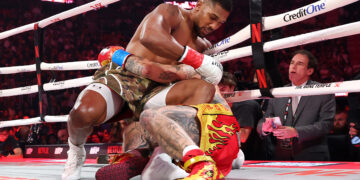
In Mixed Martial Arts, the 12-6 elbow is a downward elbow strike that follows a vertical path toward its target. Think of it as trying to draw a line between the 12 and 6 marks on a clock with your elbow.
12-6 elbows were removed from the list of banned techniques in the Unified MMA rules on 23 July 2024 after the Association of Boxing Commissions and Combative Sports voted on it. The longstanding ban was viewed as one of the most controversial rules in mixed martial arts because of the silly reason it was banned in the first place. As unbelievable as it sounds, the 12-6 elbow was banned because some commissioners watched videos of Karatekas breaking piles of concrete slabs with them. After seeing that, they figured the technique was too risky for mixed martial arts.
One of the most controversial results of 12-6 elbows being banned was current UFC heavyweight champion Jon Jones getting disqualified during his 2009 fight with Matt Hamill. Jones was an up-and-coming star on his way to the light-heavyweight title at the time, but he ended up getting disqualified after landing a 12-6 elbow on Hamill. Hamill was in over his head from the opening seconds of the fight, and it was crystal clear Jones was seconds away from winning the fight before he was disqualified. That loss remains the only loss of Jones’s record. It will probably be overturned in the coming years.
Mastering The 12-6 Elbow
The 12-6 elbow is a downward strike with the point of your elbow. Unlike other elbow strikes previously used in mixed martial arts, it follows a straight path to its target, allowing gravity to add a little more force to the strike.
The 12-6 elbow is arguably the most natural elbow to throw in clinch or ground positions. Swinging your elbow up and driving straight down on an opponent feels natural in many of these positions, allowing you to generate more power since it doesn’t involve any awkward movements. Picture someone trying to perform a sloppy takedown on you with their head pressed against your torso and their arms wrapped around your hips. What feels more natural, driving an elbow straight down or swinging your elbow horizontally?
Breaking Down The Mechanics Of The 12-6 Elbow
Let’s take a close look at how 12-6 elbows should be thrown to gain more insights into the technique:
1) Positioning
12-6 elbows are typically most effective on opponents when you have a dominant ground position or have successfully sprawled out of a takedown. The high-top mount is arguably the best position to throw them from since your opponent’s ability to defend themselves is limited. Jon Jones was in this position when he was disqualified, and the elbows he threw hurt Hamill.
2) Body Alignment
Your torso should be aligned with the target while your core should be engaged when throwing 12-6 elbows, meaning if you drew a straight line through your body and beyond, your belly button and the target should be on it. The force behind the elbow strike should be generated from your upper arms and shoulders.
3) Elbow Placement
The point of your elbow should make contact with the target, and the motion toward it should be a vertical line. Any deviation from this path takes some power off the technique. Aim for vulnerable areas like the head, torso, or liver area (left side of the body).
Start working on the technique using grappling dummies and similar training tools to master it. It’s a very straightforward technique, so understanding its intricacies requires little practice. You can also practice the technique with your training partners to get more comfortable with how throwing it feels from different positions. Ensure you’re softly placing strikes and not actually hitting your training partner.
Strategic Uses Of The 12-6 Elbow
Now that the 12-6 elbows are allowed by the Unified MMA Rules, let’s take a look at some of the ways you can use it inside the cage:
1) Ground And Pound
The 12-6 elbow is an excellent tool to have in your arsenal when you have top positions on the ground. If you can posture up from a position, you can probably throw 12-6 elbows. The top and side mount should be the main positions where you seek to land these elbows since you can easily posture up while controlling your opponent to keep them there.
Long-limbed fighters can land 12-6 elbows from top guard but leave themselves vulnerable to submissions. You can also land 12-6 elbows from the top back mount as long as you don’t hit the back of the head. Your target would be the shoulders from that position.
2) Clinch Strikes
All sorts of elbow strikes are thrown from clinch positions, and 12-6 elbows can be just as effective from there, especially for taller fighters. Since your opponent can also throw strikes, you must be wary of counterstrikes when throwing 12-6 elbows from clinch positions. A sneaky way to throw it from the clinch is to start with an upward elbow aimed at the face and come right back down with a 12-6. That way, you don’t telegraph your intent.
3) Takedown Defense
12-6 elbows can be effective when defending against takedowns. You’ll have to be careful to avoid hitting the back of your opponent’s head because of the strike’s trajectory, but you can take something off your opponent’s punches by targeting their shoulders when they shoot in on you.
Always prioritize defending the takedown before throwing strikes. Ideally, you want to be in the top sprawl position before throwing 12-6 elbows.
Add This Powerful Elbow Technique To Your Arsenal
While the 12-6 elbow has been banned for most of the time mixed martial arts has existed, it will quickly become one of the most used elbow techniques in the sport now that it’s legal as sanctioning bodies worldwide follow the ABC’s lead. The elbow’s path allows you to generate more force as you drive its tip into your target, making it the most powerful type of elbow strike.
You may also like:
Breaking Down The Powerful Style Of Anatoly “Sladkiy” Malykhin
Anatoly “Sladkiy” Malykhin is a special breed of fighter. The triple-champ from ONE Championship is the first MMA fighter to win titles in three different weight classes in a major MMA promotion, and the first…
In an MMA and wrestling match, the suplex is one of those techniques that will surely capture an audience’s attention. Some may think it is not for everybody and requires one to be an athletic…
The back mount is the most dominant position in grappling sports such as BJJ. It allows you to submit your opponents or rain down strikes in an MMA match while keeping them second-guessing. Getting there…
You’ve probably heard the expression “fight IQ” often when watching combat sports like mixed martial arts. The term refers to a fighter’s ability to make the right decisions consistently during the heat of battle. This…
In the world of Brazilian Jiu-Jitsu and Mixed Martial Arts, positional dominance is one of the most critical skills to master. The mount position is one of the most sought-after positions in the world of…
Have you ever watched a mixed martial arts weigh-in and thought, “How the heck did that behemoth fit into that weight class yesterday?” or “Why is that fighter hugging a gallon jug of water like…
Posture is an essential aspect of BJJ and life. From a grappling perspective, it is a defense mechanism to prevent getting caught by threats on the mats and is an effective way to impose your…
The uppercut is arguably the most devastating punch used in boxing. Its upward trajectory often allows it to thread between an opponent’s guard and make contact with their chin. The punch can be equally destructive…
When you first started your Muay Thai journey you were probably bursting with excitement. You went to every session possible, lapping up every bit of knowledge and advice given to you by your coaches and…
Martial art classes for kids might just be what you need to get your child off the couch and go break a sweat. Obesity rates among adolescents and children between the ages of 5 to…
Good posture comes with its share of perks like helping you make a better first impression when you meet new people. Good posture gives you an air of authority and makes you appear taller than…
The body clinch and throw is an effective technique, commonly used by many Muay Thai fighters when they are locked in a clinch battle with a taller opponent. If you are ever up against a…





![[WATCH] IND vs SA 2025: Umpire Rohan Pandit down in pain as Sanju Samson drive hits knee](https://babu88sports.com/wp-content/uploads/2025/12/watch-ind-vs-sa-2025-umpire-rohan-pandit-down-in-pain-as-sanju-samson-drive-hits-knee-360x180.jpg)




























